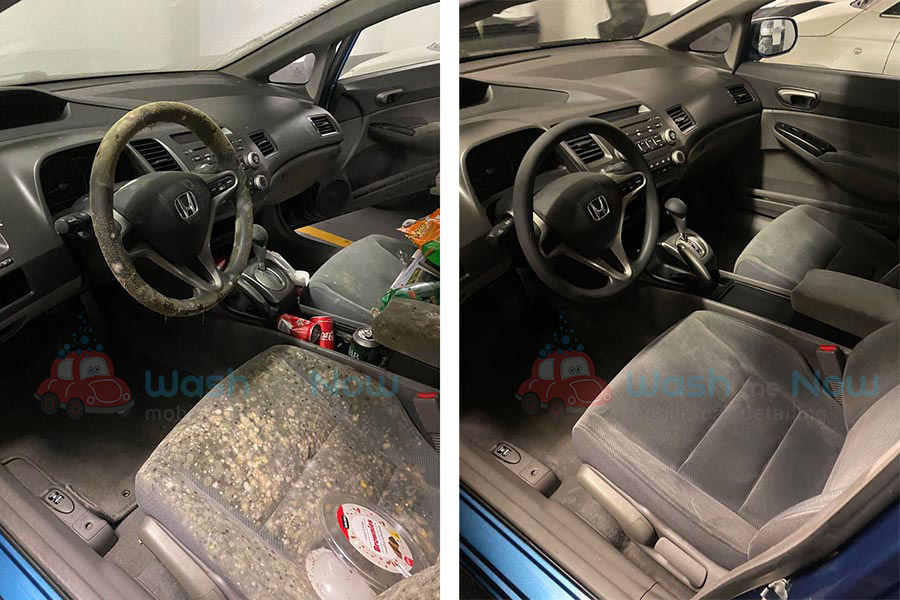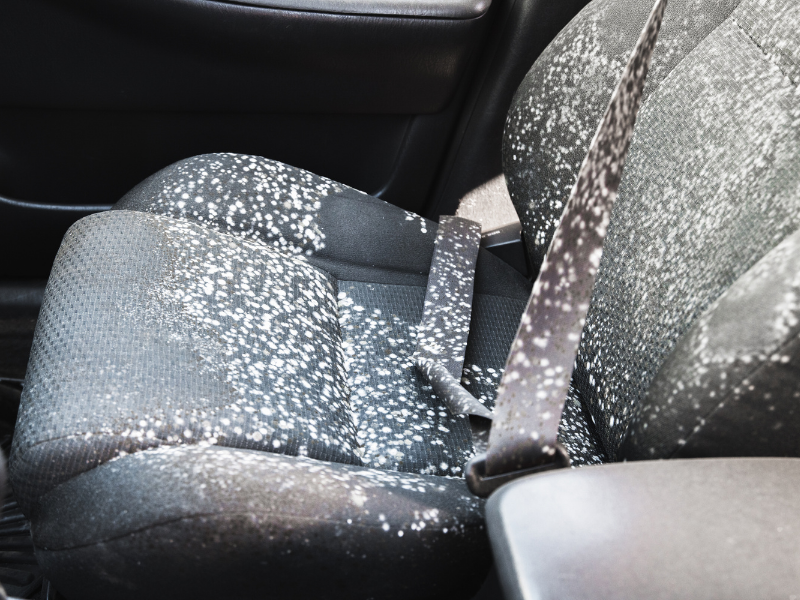To remove mold from a car interior, start by vacuuming the affected areas to remove loose mold spores. Then, use a mixture of water and mild detergent to clean the surfaces.
Additionally, consider using a mold removal spray or a mixture of vinegar and water for tougher mold stains.

Credit: www.washmenow.ca
Identifying Mold In Car Interior
Having mold in your car’s interior not only diminishes the overall appeal of your beloved automobile but can also be hazardous to your health. Mold thrives in warm and moist environments, making your car an ideal breeding ground. So, it is crucial to know how to identify mold in your car interior to take immediate action and prevent further damage. In this section, we will explore the signs of mold growth and the common areas where mold is often found.
Signs Of Mold Growth
It’s essential to be able to spot the signs of mold growth in your car. Here are some unmistakable indicators that your car may have a mold problem:
- Unpleasant, musty odor: If you notice a damp, earthy smell that lingers in your car, it could be a sign of mold growth.
- Visible discoloration: Mold can appear in various colors, such as black, green, or white, and it may leave stains or discoloration on surfaces.
- Peeling or bubbling surfaces: Mold can cause paint or wallpaper to bubble or peel off, indicating that there is underlying moisture and mold growth.
- Allergic reactions: If you experience frequent sneezing, coughing, or watery eyes when inside your car, it could be due to mold spores in the air.
Common Areas Where Mold Is Found
Mold can infest various parts of your car’s interior, especially those prone to moisture buildup. Here are the common areas where mold is often found:
| Area | Reason for Mold Growth |
|---|---|
| Carpet | Trapped moisture from wet shoes, spills, or leaks |
| Seats | Accumulated sweat or liquid spills |
| Dashboard and console | Condensation from temperature changes |
| Trunk | Water leaks or moisture buildup |
| Air conditioning vents | Humid air passing through the vents |
Now that you know the signs to look out for and the common areas where mold is often found, you can proactively inspect your car and take the necessary steps to remove mold promptly. In the next section, we will delve into effective methods of removing mold from your car’s interior.

Credit: www.puroclean.com
Removing Mold From Car Interior
When it comes to maintaining a clean and healthy car interior, getting rid of mold is a top priority. Mold not only looks unsightly, but it can also pose serious health risks if left untreated. In this guide, you will learn the step-by-step process to safely remove mold from your car interior. By following these instructions and taking the necessary safety precautions, you can eliminate mold and restore your car’s interior to its pristine condition.
Safety Precautions
To ensure that you stay safe while removing mold from your car’s interior, it is crucial to take the necessary safety precautions. Mold spores can cause allergic reactions and respiratory problems, so proper protection is essential. Before starting the mold removal process, make sure to:
- Wear gloves, safety goggles, and a face mask to protect your skin, eyes, and respiratory system from mold spores.
- Work in a well-ventilated area, either outdoors or with windows and doors open, to minimize exposure to mold spores.
- Dispose of contaminated materials, such as wipes and rags, in a sealed plastic bag to prevent further contamination.
Tools And Materials Needed
Before you begin, gather all the necessary tools and materials for removing mold from your car’s interior. Having everything within reach will make the process more efficient. Here’s what you will need:
| Tools | Materials |
|---|---|
| Soft-bristle brush | Vinegar |
| Microfiber cloths | Baking soda |
| Vacuum cleaner with upholstery attachment | Water |
| Plastic scraper | Lavender or tea tree oil |
| Carpet cleaner | Disposable gloves |
Step-by-step Mold Removal Process
Now that you have taken the safety precautions and gathered the necessary tools and materials, it’s time to start removing the mold from your car’s interior. Follow these steps:
- Begin by vacuuming the affected areas with a vacuum cleaner equipped with an upholstery attachment. This will help remove any loose mold spores and debris.
- Next, mix equal parts vinegar and water in a spray bottle. Spray the solution onto the moldy areas.
- Gently scrub the moldy surfaces with a soft-bristle brush. Pay close attention to areas where mold may be hidden, such as under the seats and in the trunk.
- Rinse the surfaces with clean water and wipe them dry with a microfiber cloth.
- If any mold stains remain, mix baking soda with water to create a paste. Apply the paste to the stained areas and let it sit for a few minutes before scrubbing it off.
- To eliminate any residual mold and prevent future growth, use lavender or tea tree oil. Mix a few drops of the oil with water in a spray bottle and mist the surfaces.
- After allowing the oil to air dry, vacuum the car once again to remove any remaining mold spores.
By following these steps, you can effectively remove mold from your car’s interior and maintain a clean and healthy environment. Remember to always take the necessary safety precautions and use the appropriate tools and materials for the job.
Preventing Mold In Car Interior
Mold growth in a car interior can cause unpleasant odors, health hazards, and damage to the upholstery. To avoid these problems, it’s essential to take preventive measures to keep your car interior mold-free. By implementing regular cleaning and maintenance practices, as well as controlling moisture and humidity levels, you can effectively prevent mold from taking hold. Let’s explore these preventive steps in detail:
Regular Cleaning And Maintenance
Cleaning your car interior regularly is the first line of defense against mold growth. Here are some important cleaning tasks to incorporate into your routine:
- Vacuum the interior: Remove any loose dirt, dust, and debris using a vacuum cleaner. Pay extra attention to the seats, floor mats, and crevices where mold can accumulate.
- Wipe down surfaces: Use a damp cloth or an appropriate cleaning solution to wipe down all surfaces, including the dashboard, steering wheel, door panels, and armrests. This helps remove any potential sources of mold growth, such as food or liquid spills.
- Clean and condition upholstery: Follow the manufacturer’s recommendations to clean and condition your car’s upholstery. Regularly doing so not only keeps your seats looking good but also prevents mold from finding a favorable environment to grow.
- Keep windows and sunroof closed: When parking your car outdoors, try to keep the windows and sunroof closed as much as possible. This prevents rainwater, humidity, and other external factors from seeping into your car.
Controlling Moisture And Humidity
Mold thrives in environments with excess moisture and humidity. To keep mold at bay, take the following steps to maintain optimal moisture levels inside your car:
- Avoid wet items: Don’t leave wet clothes, towels, or other items inside your car, as they can contribute to increased humidity and create a breeding ground for mold.
- Address water leaks promptly: If you notice water leaks in your car, particularly around doors, windows, or the trunk, it is crucial to address them as soon as possible. Fixing the source of the leak helps prevent water from accumulating and reduces the risk of mold growth.
- Use moisture-absorbing products: Consider using moisture-absorbing products, such as desiccant packs or silica gel, in your car. These products help absorb excess moisture and maintain a dry environment that discourages mold growth.
- Utilize proper ventilation: Whenever possible, open windows or turn on the air conditioner to improve air circulation in your car. Adequate ventilation helps reduce moisture levels and create an unfavorable environment for mold to thrive.
By incorporating these regular cleaning practices and moisture control measures, you can significantly reduce the chances of mold growth in your car interior. Taking proactive steps to prevent mold not only ensures a clean and fresh driving experience but also helps preserve the value and longevity of your vehicle.

Credit: www.autodetaildoctor.com
Conclusion
Dealing with mold in your car can be a challenging task, but with the right approach, you can have a mold-free interior in no time. From thorough cleaning to proper ventilation, these steps can help you tackle the issue effectively.
Remember to address the root cause of moisture and maintain regular cleaning routines to prevent mold from returning. By following these tips, you can enjoy a fresh and healthy car interior for a comfortable journey.

